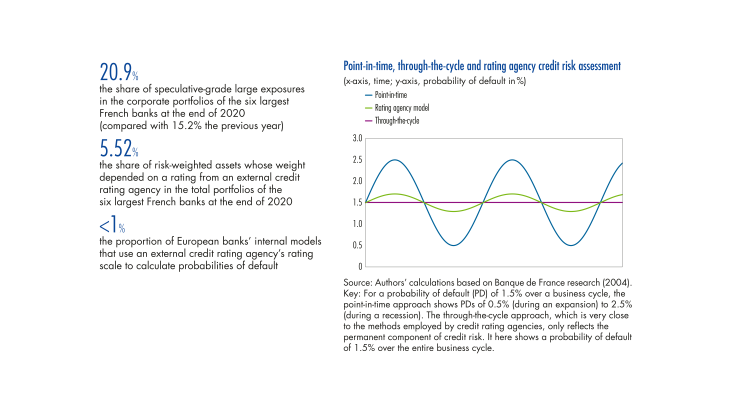1. A review of the literature sheds light on the procyclicality of credit ratings
What is meant by procyclicality?
With reference to the concept of the financial accelerator of Bernanke et al. (1996), procyclicality can be defined here as the propensity of endogenous credit market developments to spread and amplify the effects of initial real or monetary shocks. This mechanism results from imperfections in the conduct of trade and the conclusion of contracts in capital markets, in particular information asymmetries between creditors and borrowers and the associated principal agent relationship. These asymmetries explain why the premium paid by firms when seeking financing on credit markets (compared to internal equity funding) is higher when the borrower’s net worth or wealth is lower. Thus, when the borrowers’ net worth fluctuates with the business cycle, for example due to the procyclicality of earnings and asset prices, the external financing premium is countercyclical: the decrease in net worth that follows the decline in asset prices increases the external financing premium. This therefore amplifies the effects of the initial shock to production, consumption and investment. Since the subprime mortgage crisis and the European sovereign debt crisis, credit ratings have often been accused of being procyclical in that, through the financial accelerator channel, a downgrade can increase a firm’s or state’s external financing costs and thus lead to a further deterioration of its solvency. The numerous methodological difficulties inherent to the process of rating borrowers’ creditworthiness have pushed authorities to reduce the mechanical dependence of the financial regulatory framework on these entities’ ratings.
The question of the procyclicality of external ratings thus requires an understanding of the methods used by agencies to assign ratings and how they take the business cycle into consideration. First, it is important to make a distinction between the procyclicality of rating methods or policies (implying stricter standards during a recession than during an expansion) and the procyclicality of the ratings themselves: more downgrades during a recession than during an expansion is not necessarily proof of a procyclical ratings policy as credit risk increases mechanically during a recession. Lastly, the use of – and reaction to – external ratings by institutions and market participants (investors, central banks, supervisory authorities, etc.) constitutes a third source of procyclicality. Their reaction, subject to regulatory frameworks, market conventions, the position of the business cycle and possible constraints linked to investment mandates, can trigger a procyclical dynamic. This section aims to shed light on the procyclicality, or absence thereof, of rating agencies’ methods and the ratings themselves. The third source of procyclicality will be considered in the third section.
[to read more, please download the article]
